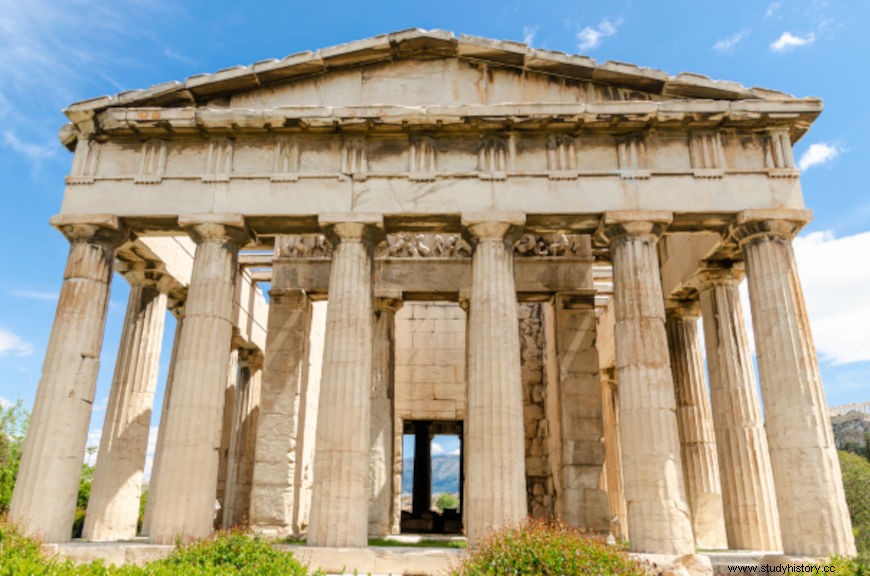
Hephaestus he was present in the religiosity of the ancient Greeks as the god of metallurgy, artisans, fire, volcanoes, among others. He was seen as a very skilled god and was responsible for the production of various mythological objects of value, such as the shield of Zeus and the helmet of Hades.
He was the son of Hera, the goddess who generated in parthenogenesis, that is, without the need for a partner. However, his appearance was so grotesque that his own mother would have thrown him from the top of Mount Olympus. Hephaestus was a respected god, and the center of his cult was on Lemnos, although Athens hosted important festivals in his honor.
Read more: Apollo — one of the most revered and well-known Greek deities
Summary on Hephaestus
-
he was, for the ancient Greeks, the god of metallurgy, artisans, fire, volcanoes, among others.
-
he had a hideous appearance and was lame in one leg.
-
he was the son of Hera, the goddess who fathered him in parthenogenesis.
-
About him being thrown from Mount Olympus, there is a version that Hera would have done it, and another that points to Zeus as responsible for the act.
-
he Married Aphrodite, goddess of beauty, but was constantly betrayed by her.
Who was Hephaestus?
Hephaestus was a deity that was part of Greek mythology, the set of myths that formed the religiosity of the ancient Greeks. He was recognized as god of metallurgy, artisans, fire, volcanoes , between others. For his attributes, he was also considered the patron of blacksmiths, sculptors and craftsmen in general.
Hephaestus was known for his great skills as a craftsman and as the one who made the weapons and armor used by the Olympic gods . The helmet of Hades, which gave him the power of invisibility, for example, was made by the lame god. He also made Zeus' shield and scepter, and he even opened the god's head with an ax so that Athena could be born.
Hephaestus was lame , that is, lame, for one of his legs was unhealthy. Furthermore, he had a hideous appearance , and the junction of the two things made his image something unique, as the standard of the Greek gods was physical and aesthetic perfection.
The forge of Hephaestus was near the s vulc ions Etna and Vulcan, both in Sicily. It was in this place where he operated his production, more specifically inside his bronze palace. His skills earned him some epithets, such as Chalkeús, referring to the office he performed.
Some historians theorize that the characteristic of Hephaestus being a deformed and lame god may have been a reference to the poor health conditions of blacksmiths in Ancient Greece, since it was a craft hard and dangerous.
Whose son was Hephaestus?
In Greek mythology there are two versions for the birth of Hephaestus. One of them claims that he was son of Hera and Zeus , however, the more traditional one claims that he was only the son of Hera and that he had been born by parthenogenesis. This would have happened because Hera was enraged that Zeus had spawned Athena in the same way.
Hephaestus was born with the hideous features and this created a deep disgust in Hera. As a result, the mother threw her son off Olympus, and in the fall, he would have fallen into the ocean, where he was rescued by Thetis (Achilles' mother) and Eurynome. Both raised him safely. This fall lasted nine days and nine nights until he finally reached the ocean.
Another version points out that Hephaestus was thrown from high Olympus by Zeus as revenge for protecting Hera. In this version, Hera was imprisoned by Zeus, but her son freed her. Zeus then threw him from the heights of Olympus, and this fall lasted a whole day. Finally, Hephaestus fell to Lemnos, a Greek city. The impact with the ground was so great that it left the god lame. After recovering from the fall, Hephaestus became one of the most important gods for Lemnos.
Read more: Dionysus — god of parties, wine, merriment, and theater
Hephaestus and Aphrodite
Hephaestus married Aphrodite as part of a pledge from Hera after she was rescued by her son from the chains that imprisoned her. Other versions point out that the marriage took place as a way to avoid misunderstandings between the gods for the goddess of beauty and love.
The Hephaestus and Aphrodite's marriage was an unhappy one because she didn't like her husband because of his appearance. Aphrodite then betrayed him several times , especially with Ares, the god of war. Hephaestus discovered the betrayal on account of Helios, the sun god, who saw the lovers together.
Hephaestus then prepared a magical net that trapped Hephaestus and Aphrodite in bed the moment they were together. Afterwards, the husband invited all the gods of Olympus to mock the lovers arrested and caught in the act. Aphrodite fled u to Cyprus after that what if separated of Hephaestus .
Hephaestus also tried to relate to Athena, the Greek goddess who remained a virgin. Athena refused to get involved with Hephaestus, and so he tried to rape her, but to no avail. In this attempt, Hephaestus threw his semen on the ground, and from that semen came the Athenians, inhabitants of Athens.
Worship of Hephaestus

Hephaestus was worshiped by the Greeks as were several other gods. The city of Lemnos centered the cult of he , but other cities also worshiped him in temples. In Athens, for example, a temple was found honoring both Hephaestus and Athena.
This temple was where important religious festivals took place. At one of these festivals, blacksmiths from all over Greece flocked to Athens to worship Hephaestus. Important statues of him were found there. Other places like Agrigento and Lycia they also had important cults to the god of metallurgy.
